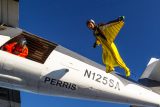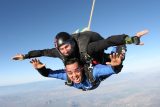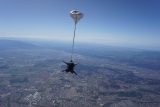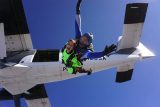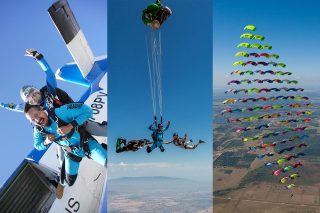
Stay Connected
Get personalized newsletters tailored to your interests! Choose from tandem skydiving, indoor skydiving, fun jumper events, or happenings at the Bombshelter Restaurant and Bar.
Posted by: Skydive Perris
7 years ago
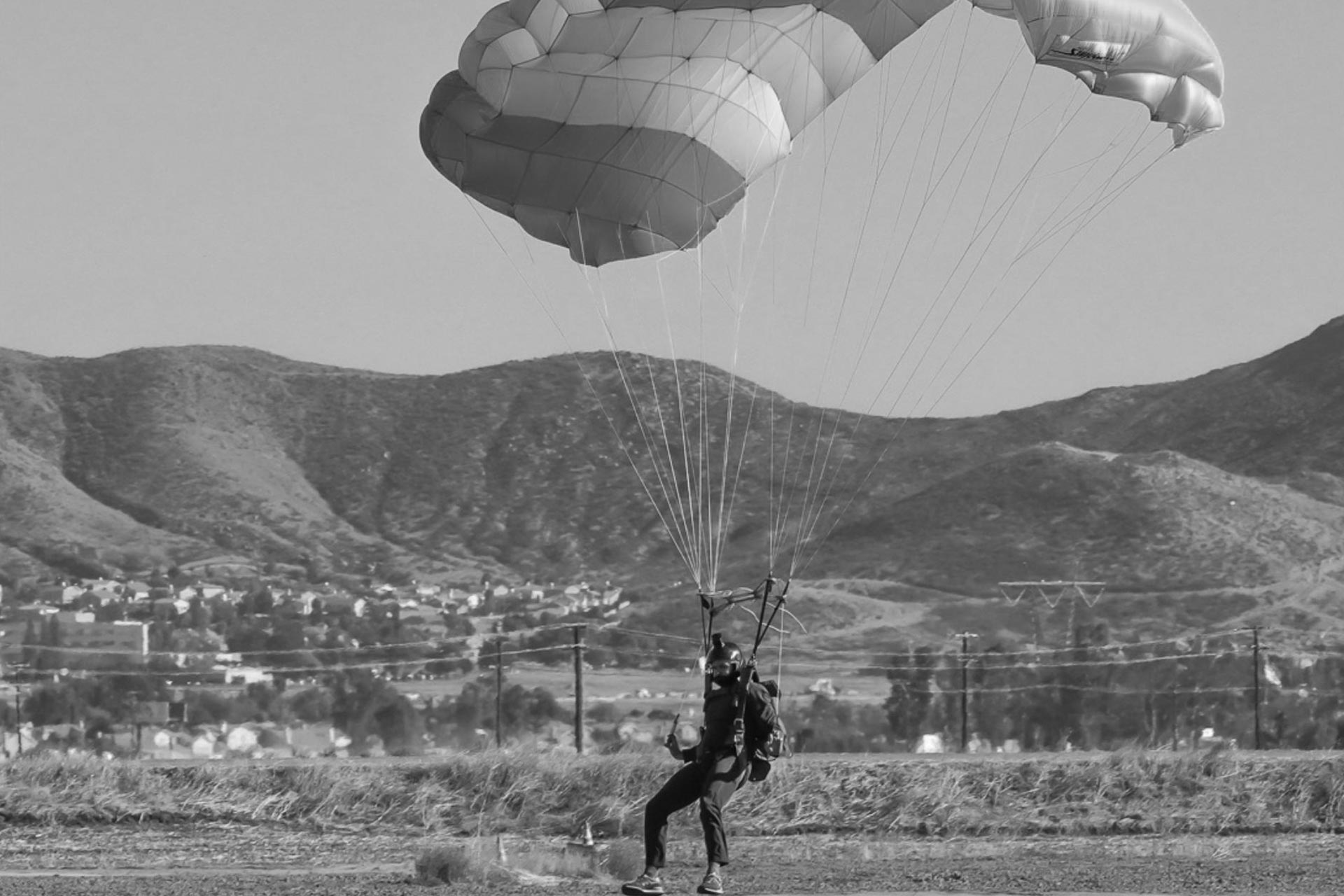
Skydivers love a challenge, and skydiving at night certainly counts! Because night jumps are a significant step up in risk, they are not available for first-time tandem skydivers at most dropzones in America–but sport skydivers rub their paws together at the chance to work the edges off of their comfort zones.
For experienced skydivers, here’s why we think nighttime is the right time for some freefall fun:
When you’ve been making eight jumps a day at a certain dropzone for the past two weeks, you start to get to know the terrain like the back of your hand. Even upside-down and backwards, you know immediately where you are–a baseball field over here; an L-shaped building there; the way two major roads cross each other at a certain point. You learn to triangulate the colors and corners of the map below and orient yourself accordingly. Don’t get us wrong–it’s nice to know where you are when you’re falling at terminal velocity, thousands of feet above the ground–but we’re skydivers. We like to change it up.
When the lights are out, it’s a whole different game. The contours of fields and waterways suddenly disappear, leaving you with a general impression of the picture, but without the detail. When skydiving at night, dropzones make special arrangements to help skydivers point out the spot–say, arranging a line of cars, headlights on, to illuminate the landing area–but it’s still a challenge to find when you’re hanging your head out the door at full altitude.
Skydivers are used to using their depth perception in order to land. Makes sense, right? Well: when you’re landing a skydive at night, your powers of depth perception are highly impaired. Especially when you’re landing a small, zippy parachute, these differences can equal a seriously challenging situation with quite a small margin for error. Night skydiving, therefore, tests the jumper’s inherent understanding of his/her equipment (and, hopefully, helps them become more skillful because of the extra brain exercise).
That’s not all, folks. There are other challenges to meet! Night jumps are infrequent, after all, and so skydivers are less familiar with (and less proficient in dealing with) the new environment. First of all: a jumper’s own shadow, cast by the moon, can look just like another jumper underneath you. (Confusing, much?) And–since the skydiver can’t physically take in the information as quickly and efficiently as in the daytime–it takes more time to react to each situation as it arises. Remember: skydiving maneuvers operate in fractions of a second.
So, how do people skydive at night? In order to be certain we see each other in the air, each skydiver is required to wear lights on the jump. As you might imagine, lots of skydivers get pretty creative with these! Curious?
Want to try it out for yourself? Come and get your skydiving license with Skydive Perris! We’d love to join you in a jump by the pale moonlight.
Copyright © 2024, Skydive Perris, All Rights Reserved.
Website Design by Beyond Marketing

| Cookie | Duration | Description |
|---|---|---|
| AWSALBCORS | 7 days | Amazon Web Services set this cookie for load balancing. |
| cookielawinfo-checkbox-advertisement | 1 year | Set by the GDPR Cookie Consent plugin, this cookie records the user consent for the cookies in the "Advertisement" category. |
| cookielawinfo-checkbox-analytics | 11 months | This cookie is set by GDPR Cookie Consent plugin. The cookie is used to store the user consent for the cookies in the category "Analytics". |
| cookielawinfo-checkbox-functional | 11 months | The cookie is set by GDPR cookie consent to record the user consent for the cookies in the category "Functional". |
| cookielawinfo-checkbox-necessary | 11 months | This cookie is set by GDPR Cookie Consent plugin. The cookies is used to store the user consent for the cookies in the category "Necessary". |
| cookielawinfo-checkbox-others | 11 months | This cookie is set by GDPR Cookie Consent plugin. The cookie is used to store the user consent for the cookies in the category "Other. |
| cookielawinfo-checkbox-performance | 11 months | This cookie is set by GDPR Cookie Consent plugin. The cookie is used to store the user consent for the cookies in the category "Performance". |
| CookieLawInfoConsent | 1 year | CookieYes sets this cookie to record the default button state of the corresponding category and the status of CCPA. It works only in coordination with the primary cookie. |
| PHPSESSID | session | This cookie is native to PHP applications. The cookie stores and identifies a user's unique session ID to manage user sessions on the website. The cookie is a session cookie and will be deleted when all the browser windows are closed. |
| viewed_cookie_policy | 11 months | The cookie is set by the GDPR Cookie Consent plugin and is used to store whether or not user has consented to the use of cookies. It does not store any personal data. |
| YII_CSRF_TOKEN | session | This cookie is used a unique token that used in securing forms and other website inputs against XSS attacks. |
| __cf_bm | 1 hour | This cookie, set by Cloudflare, is used to support Cloudflare Bot Management. |
| Cookie | Duration | Description |
|---|---|---|
| currency | session | This cookie is used to store the currency preference of the user. |
| lang | session | LinkedIn sets this cookie to remember a user's language setting. |
| Cookie | Duration | Description |
|---|---|---|
| AWSALB | 7 days | AWSALB is an application load balancer cookie set by Amazon Web Services to map the session to the target. |
| Cookie | Duration | Description |
|---|---|---|
| ahoy_visit | 4 hours | This cookie is set by Powr for analytics measurement. |
| ahoy_visitor | 1 year 1 month 4 days | This cookie is set by Powr for analytics measurement. |
| CONSENT | 2 years | YouTube sets this cookie via embedded YouTube videos and registers anonymous statistical data. |
| vuid | 1 year 1 month 4 days | Vimeo installs this cookie to collect tracking information by setting a unique ID to embed videos on the website. |
| _fbp | 3 months | Facebook sets this cookie to display advertisements when either on Facebook or on a digital platform powered by Facebook advertising after visiting the website. |
| _ga | 1 year 1 month 4 days | Google Analytics sets this cookie to calculate visitor, session and campaign data and track site usage for the site's analytics report. The cookie stores information anonymously and assigns a randomly generated number to recognise unique visitors. |
| _gat_UA-* | 1 minute | Google Analytics sets this cookie for user behaviour tracking. |
| _ga_* | 1 year 1 month 4 days | Google Analytics sets this cookie to store and count page views. |
| _gcl_au | 3 months | Google Tag Manager sets the cookie to experiment advertisement efficiency of websites using their services. |
| _gid | 1 day | Google Analytics sets this cookie to store information on how visitors use a website while also creating an analytics report of the website's performance. Some of the collected data includes the number of visitors, their source, and the pages they visit anonymously. |
| Cookie | Duration | Description |
|---|---|---|
| fr | 3 months | Facebook sets this cookie to show relevant advertisements by tracking user behaviour across the web, on sites with Facebook pixel or Facebook social plugin. |
| IDE | 1 year 24 days | Google DoubleClick IDE cookies store information about how the user uses the website to present them with relevant ads according to the user profile. |
| test_cookie | 15 minutes | doubleclick.net sets this cookie to determine if the user's browser supports cookies. |
| VISITOR_INFO1_LIVE | 6 months | YouTube sets this cookie to measure bandwidth, determining whether the user gets the new or old player interface. |
| YSC | session | Youtube sets this cookie to track the views of embedded videos on Youtube pages. |
| yt-remote-connected-devices | never | YouTube sets this cookie to store the user's video preferences using embedded YouTube videos. |
| yt-remote-device-id | never | YouTube sets this cookie to store the user's video preferences using embedded YouTube videos. |
| yt.innertube::nextId | never | YouTube sets this cookie to register a unique ID to store data on what videos from YouTube the user has seen. |
| yt.innertube::requests | never | YouTube sets this cookie to register a unique ID to store data on what videos from YouTube the user has seen. |
| Cookie | Duration | Description |
|---|---|---|
| ahoy_track | session | No description available. |
| currencyBase | session | No description available. |
| currencySymbol | session | Description is currently not available. |
| landingCatalogURL | session | No description available. |
| test-third-party-cookie | session | Description is currently not available. |
| VISITOR_PRIVACY_METADATA | 6 months | Description is currently not available. |
